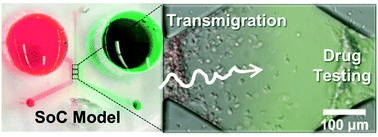Investigations on T cell transmigration in a human skin-on-chip (SoC) model†
Abstract
A microfluidics-based three-dimensional skin-on-chip (SoC) model is developed in this study to enable quantitative studies of transendothelial and transepithelial migration of human T lymphocytes in mimicked skin inflammatory microenvironments and to test new drug candidates. The keys results include 1) CCL20-dependent T cell transmigration is significantly inhibited by an engineered CCL20 locked dimer (CCL20LD), supporting the potential immunotherapeutic use of CCL20LD for treating skin diseases such as psoriasis; 2) transepithelial migration of T cells in response to a CXCL12 gradient mimicking T cell egress from the skin is significantly reduced by a sphingosine-1-phosphate (S1P) background, suggesting the role of S1P for T cell retention in inflamed skin tissues; and 3) T cell transmigration is induced by inflammatory cytokine stimulated epithelial cells in the SoC model. Collectively, the developed SoC model recreates a dynamic multi-cellular micro-environment that enables quantitative studies of T cell transmigration at a single cell level in response to physiological cutaneous inflammatory mediators and potential drugs.



 Please wait while we load your content...
Please wait while we load your content...
